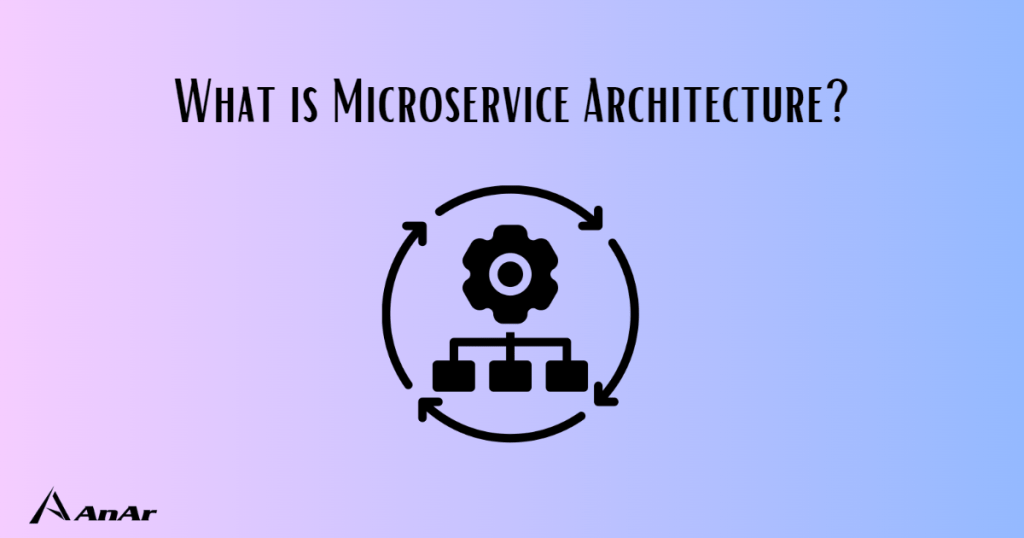
What is Microservice Architecture?
Microservices, or microservice architecture, is a specific software design methodology that involves breaking down a single application into a collection of loosely coupled services. As applications evolve from a monolithic architecture over time, they tend to grow into interconnected microservices.
The primary idea behind microservices is that specific apps are easier to develop and maintain when broken down into small, interdependent components. Although this approach involves increased complexity, microservices still offer numerous advantages over monolithic architecture, such as scalability, flexibility, and fault tolerance.
Microservices as a concept
The concept of microservices originated from the prevalent monolithic architecture that most companies adopted, especially those established for ten years or more. Unlike the monolithic approach, microservices architecture involves designing each component as a separate service with its own CPU, runtime environment, and often a dedicated team. This ensures that each service is unique and operates independently of the others.



In this architecture, each microservice has the capability to:
- Execute its own unique process.
- Communicate independently without being dependent on other microservices or the overall application
The capability of being divided and integrated protects the entire system from deterioration, allowing agile processes to operate more effectively. This makes the microservices architecture attractive to organizations, particularly those still employing monolithic infrastructures, as it offers numerous software development and maintenance benefits.
How does microservices architecture function?
Microservices are a group of services that work together to run an application. They use APIs to communicate and exchange information between services. The team building each service decides on the software and hardware used. This allows for more flexible team communication and easier service upgrades, making software development more resilient.
Kubernetes has played a crucial role in advancing the adoption of microservices architecture, although it is not mandatory. The growing popularity of cloud computing and networked computers has led to two significant changes:
- Eliminated the need for users to have high-performance computers to run complex operations.
- Shifted the responsibility of running the service to the company, which employs individual servers every time a user runs the application, resulting in improved performance and scalability.
Microservices architecture distributes an application’s functionality into independently deployable and scalable services, each with its own distinct processes and communicating through APIs. While the user’s machine may perform some basic processing, its primary role in microservices is to send and receive network calls to and from other services rather than processing all of the application’s functionality. When using an application, it’s common to assume that multiple computers are involved in powering the experience. For popular apps such as Facebook or Uber, estimating that up to 10,000 computers are actively processing information to enhance the user experience is not unreasonable. At the same time, for other applications, this number may vary.
Difference between Monolithic Architecture and Microservices Architecture:
To understand the difference between monolithic and microservices architecture, it’s helpful to compare the two. Monolithic architecture is like a single self-contained unit or a client-server model. In a monolithic server-side application, an HTTP request retrieves or updates data in the underlying database. But when using monolithic architecture, any change requires a full rebuild and deployment of the entire application.
On the other hand, microservices architecture comprises individual, modular services that can be changed and deployed independently. This means that a specific component can be updated without disturbing the rest of the software. This approach allows for more flexibility and agility in software development, as changes can be made quickly and easily. Additionally, microservices architecture enables better scalability, fault tolerance, and resilience. Individual micro-services can be scaled up or down as needed, and failures are contained to a single service rather than affecting the entire application.
Service-Oriented Architecture (SOA) and Microservice Architecture (MSA) —
In the past, many companies used Service-Oriented Architecture (SOA) to design their software. Nowadays, microservice architecture (MSA) is preferred due to its many advantages.
While there are technical differences between microservices and SOA, particularly concerning the use of the enterprise service bus (ESB), the contrast between the two can be somewhat vague. It’s more helpful to think of the difference as one of scale. SOA aimed to standardize communication and integration among all web services in an organization, while microservices architecture focuses on a specific application.
The article “SOA vs. Microservices: What’s the Difference?” by IBM provides more extensive information on this topic.
Microservices architecture both facilitates and necessitates the use of DevOps.
Microservices architecture is often considered tailor-made for DevOps and continuous integration/continuous delivery (CI/CD), as it allows for the deployment of small, individual services frequently. However, it’s important to note that the relationship between microservices and DevOps is mutually beneficial. In fact, successful implementation of microservices architectures requires DevOps practices. Monolithic applications may have certain advantages, but they are not as complex as distributed systems with multiple moving parts and independent tech stacks. The extensive complexity and dependencies that come with microservices make it crucial to invest in deployment, monitoring, and lifecycle automation to ensure smooth operation.
Key Tools for Building Microservices Architecture:
Although there is a wide range of modern tools and programming languages that are compatible with microservices architecture, there are a few fundamental tools that have become indispensable and nearly synonymous with microservices.
Dockers, Containers, and Kubernetes
Microservices are typically characterized by their small size, although there is no clear-cut definition of how much code qualifies something as a microservice.
When Docker came onto the scene in 2013, it introduced a new computing model that was well-suited for microservices. Unlike traditional virtual machines, containers are lightweight and can start up and shut down rapidly, making them ideal for the small and agile services that make up microservices architectures.
As the number of services and containers increased, managing and coordinating them became a significant challenge. Kubernetes, an open-source platform for container orchestration, has emerged as a leading solution because of its ability to effectively manage large groups of containers.
API gateways
In a microservices architecture, API communication is common, especially during initial state setup. While it is possible for clients and services to communicate directly, an intermediary layer, such as an API gateway, can be helpful, particularly as the number of services within an application grows over time. The API gateway acts as a reverse proxy for clients, routing requests, distributing them across multiple services, and providing additional security and authentication.
Various technologies, such as API management platforms, can be utilized for implementing API gateways. However, if the microservices architecture is implemented using containers and Kubernetes, the preferred options for gateway implementation are Ingress or, more recently, Istio.
Messaging and event streaming
Although designing stateless services is considered a best practice, the state still exists, and services must be aware of it. While using an API call is an effective way to initially establish a state for a service, it is not an efficient method for maintaining it. Constantly polling for updates is impractical and not scalable.
To keep services up to date, combining state-establishing API calls with messaging or event streaming is necessary. Services can broadcast changes in state, while interested parties can listen for those changes and make the necessary adjustments. A general-purpose message broker is typically the best option for this task, but there may be cases where an event streaming platform, like Apache Kafka, is more suitable. By combining microservices with event-driven architecture, developers can build distributed systems that are highly scalable, fault-tolerant, and extensible, capable of consuming and processing large amounts of real-time events or information.
Serverless
Serverless architectures are an extension of cloud and microservices patterns that aim to create even smaller units of deployment. These architectures use functions as the unit of execution, which can be just a few lines of code. While the line separating a serverless function from a microservice is not always clear, functions are generally considered to be smaller than microservices.
The similarity between serverless architectures and microservices lies in their focus on creating small, scalable units that can respond to changes in demand. Functions-as-a-Service (FaaS) platforms are an example of serverless architectures that allow developers to create and run code without needing to manage the underlying infrastructure. By leveraging serverless architectures and FaaS platforms, developers can create highly scalable and cost-effective systems that can scale precisely with demand.
How do microservices bring advantages to the organization?
Microservices are a unique architectural approach that is not only favored by developers but also by executives and project leaders. Unlike traditional architecture, microservices align with the preferred structure and processes that many business leaders desire for their teams.
These are some of the advantages that microservices can bring to businesses:-
- Scalability and Flexibility: Microservices architecture offers a scalable and flexible software solution that can improve overall software performance.
- Easy Modification and Deployment: Engineers can easily modify and deploy individual services without disrupting the entire application, resulting in improved efficiency and faster time-to-market.
- Business-Centric Architecture: Microservices architecture is built around business capabilities and priorities, making the software more agile and responsive to market demands.
- Cross-Functional Collaboration: Cross-functional teams working on individual services with a message bus allow for better collaboration and faster development times, improving overall team productivity.
- Reliability and Robustness: Microservices architecture provides better application reliability and robustness, resulting in higher uptime and less downtime.
- Similarities with UNIX Systems: Microservices architecture shares similarities with UNIX systems, optimizing software performance and reducing system complexity.
- Smart Endpoints: Smart endpoints in microservices enable faster and more efficient data processing and application logic, improving software performance and user experience.
Challenges with Microservice Architecture
The deployment, operation, and maintenance of microservices architecture pose a number of challenges. Below are some of these challenges discussed in detail.
- Microservices communication Microservices require interaction with each other, necessitating the maintenance of a fully functional API as a communication channel.
- Distributed logging Deploying independently operating microservices results in unstructured, difficult-to-organize, and maintain distributed log data.
- Distributed transaction Transactions requiring multiple microservices can cause failure across the entire transaction if one element fails.
- Cyclic dependencies Codependency of two or more services or modules can make it difficult to scale and manage microservices and make code complex to maintain.
Microservices and cloud services
Microservices and cloud computing are frequently paired for reasons beyond popularity. Microservices offer benefits such as the ability to deploy and scale components individually, resulting in cost optimizations when combined with on-demand, pay-per-use infrastructure. Additionally, microservices allow for each component to adopt the most appropriate stack for its specific task, reducing complexity and overhead when utilizing cloud services. While creating a microservices infrastructure from scratch is possible, it is not recommended, especially for beginners.
Special Features of Microservices Architecture
Microservices architecture promotes cross-platform compatibility and seamless integration across technologies, making it a highly versatile and efficient solution for modern software development. The decentralized governance of microservices encourages developers to create useful tools and code libraries that can be leveraged by others to solve similar problems, resulting in more efficient and effective development processes.
Netflix, a pioneer in microservices architecture, has successfully implemented this approach to handle up to 30% of web traffic, proving its scalability and reliability. By encouraging developers to use good code libraries and promoting decentralized data management, Netflix has set an example of how microservices architecture can lead to highly effective and efficient software development.
In addition to its many benefits, microservices architecture also enables systems to handle failure. Since multiple unique and diverse services communicate with each other, there may be instances of failure. However, with the proper tools and processes in place, these failures can be minimized and managed effectively. While this feature of a microservices architecture may seem complex, it ultimately leads to more resilient and reliable software systems.
Some examples of companies using microservices architecture:
Microservices architecture has become increasingly popular among large companies, as highlighted by technology expert Martin Fowler. Early adopters such as Netflix have paved the way for others, including eBay, Amazon, Twitter, PayPal, SoundCloud, Gilt, and The Guardian, to successfully implement this approach in their software development processes.
Let’s see why Netflix migrated its systems to a microservice architecture-
Netflix encountered scalability issues and service outages soon after starting its movie streaming business in 2007. After facing a DVD shipping failure in 2008, the company migrated to a distributed cloud system with AWS as the provider. From 2009 to 2012, Netflix moved its application architecture from monolithic to microservices, which allowed the company to overcome scalability challenges, serve millions of users worldwide, and process 2 billion API requests daily through over 500 cloud-hosted microservices in 2015. This transition also reduced streaming costs and contributed to Netflix’s financial growth.
Conclusion
So in this article, we have taken a look at what microservices are, what they can be used for, and the key benefits of using microservice architecture. If you are looking to learn more about how migrating to microservices can help your business Schedule Discussion with AnAr Experts.




